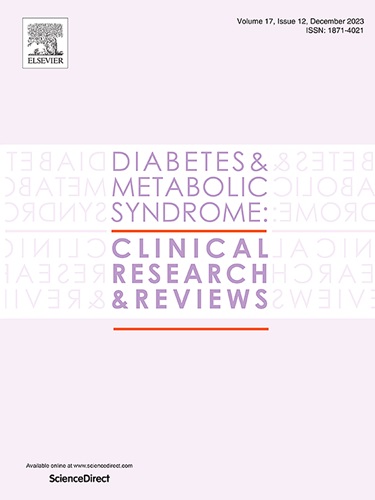Onychomycosis and future onset of type 2 diabetes
IF 3.4
Q1 ENDOCRINOLOGY & METABOLISM
Diabetes & Metabolic Syndrome-Clinical Research & Reviews
Pub Date : 2025-06-01
DOI:10.1016/j.dsx.2025.103265
引用次数: 0
Abstract
Introduction
Onychomycosis is a fungal infection of the nail with an increasing prevalence worldwide. Diabetes has been shown to elevate onychomycosis risk by 2.5-3-fold.
Objectives
The present study hypothesized that this association may represent a reverse causality relationship, namely that onychomycosis is a risk factor for diabetes, and aimed to determine if the diagnosis of onychomycosis is associated with a future diagnosis of diabetes.
Methods
We followed a large cohort of adults insured by the largest health maintenance organization in Israel, for documented diagnoses of onychomycosis and subsequent diabetes between 2000 and 2022. We used multivariate statistical modeling to evaluate hazard ratios for diabetes, while adjusting for onychomycosis treatments, co-morbidities, and demographic characteristics. Time-varying covariates were used to account for diagnosis timing.
Results
112,204 insured patients met the inclusion criteria and were followed for 19.3 years on average. Onychomycosis was diagnosed among 68,201 (60.8 %) patients and was found to be associated with an increased risk for future diabetes diagnosis (HR = 2.21, 95 %CI: 2.11,2.32, p-value<0.0001). The hazard ratio progressively increased with the number of onychomycosis diagnoses. Onychomycosis treatment was found to be associated with a decreased risk for diabetes diagnosis.
Conclusions
This study found that past onychomycosis diagnosis was associated with an increased risk for future diabetes. We thus call for laboratory investigation of the findings and their implications.
甲真菌病与2型糖尿病的未来发病
甲真菌病是一种指甲真菌感染,在世界范围内日益流行。糖尿病已被证明可使患甲癣的风险增加2.5-3倍。目的本研究假设这种关联可能代表一种反向因果关系,即甲真菌病是糖尿病的危险因素,旨在确定甲真菌病的诊断是否与未来糖尿病的诊断相关。方法:我们跟踪了以色列最大的健康维护组织在2000年至2022年期间对甲真菌病和随后的糖尿病的记录诊断的一大队列成年人。我们使用多变量统计模型来评估糖尿病的风险比,同时调整甲癣治疗、合并症和人口统计学特征。时变协变量用于解释诊断时间。结果符合纳入标准的参保患者112204例,平均随访时间19.3年。在68,201例(60.8%)患者中诊断出甲真菌病,并发现与未来糖尿病诊断风险增加相关(HR = 2.21, 95% CI: 2.11,2.32, p值<;0.0001)。随着甲真菌病诊断的增多,危险比逐渐增加。甲真菌病治疗被发现与糖尿病诊断风险降低有关。结论:本研究发现,过去的甲真菌病诊断与未来糖尿病的风险增加有关。因此,我们要求对这些发现及其影响进行实验室调查。
本文章由计算机程序翻译,如有差异,请以英文原文为准。
求助全文
约1分钟内获得全文
求助全文
来源期刊

Diabetes & Metabolic Syndrome-Clinical Research & Reviews
ENDOCRINOLOGY & METABOLISM-
CiteScore
22.90
自引率
2.00%
发文量
248
审稿时长
51 days
期刊介绍:
Diabetes and Metabolic Syndrome: Clinical Research and Reviews is the official journal of DiabetesIndia. It aims to provide a global platform for healthcare professionals, diabetes educators, and other stakeholders to submit their research on diabetes care.
Types of Publications:
Diabetes and Metabolic Syndrome: Clinical Research and Reviews publishes peer-reviewed original articles, reviews, short communications, case reports, letters to the Editor, and expert comments. Reviews and mini-reviews are particularly welcomed for areas within endocrinology undergoing rapid changes.
 求助内容:
求助内容: 应助结果提醒方式:
应助结果提醒方式:


